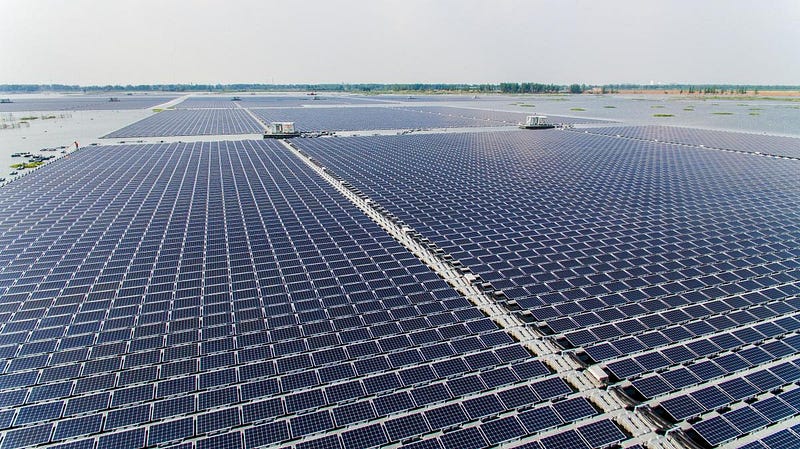by Devavrat Kadam

Largest floating solar plant in the world. (Source: yicaiglobal.com)
In the last decade, solar has experienced a compound annual growth rate (CAGR) of 60%. In addition to this, the costs to install solar have dropped by more than 60% as well. While this progress has resulted in a price war among solar companies, it has served as a great reason to innovate.
Floating solar photovoltaic (PV) represents an emerging large scale application, in which solar panels are sited on water bodies. While land-based solar installation has been championed by many companies, floating solar technology is still in its nascent stage, but fast catching up.
The world’s largest land-based solar PV plant happens to be in India, it boasts a whopping 648 MW capacity and spreads over 3.9 sq. miles (10 sq. km) containing 2.5 M panels.
Read: Challenges of tomorrow and evolution of energy infrastructure in India
In contrast, world’s largest floating solar plant in Huainan, China, commissioned by Sungrow, world’s second largest PV inverter company has an installed capacity of 40 MW with just 166,000 panels, enough to power a small town. India’s largest floating solar plant installed by NTPC, produces only 100 kWp.
Why floating solar?
Since Mesopotamia, we’ve seen human settlements being located close to water bodies for obvious reasons. Many times, these settlements are in remote locations. Connection to the grid is an expensive option, and often the last priority for many municipalities. Installing floating solar farms near these settlements will improve the socio-economic conditions and boost the floating solar farm market outside of cities.
Economically challenged households will be able to afford power. Power producing companies face problems due to lack of customer payments and power theft. A different billing model can be adopted for regions which cannot afford to pay electricity bills monthly. Solar companies can mitigate this risk and secure timely payments by using a pay-as-you-go model. Shared solar is a solid example which provides electric infrastructure to communities that are not immediately considered viable for grid connectivity.
Solar farms on water come with other sustainability benefits where water scarcity is an issue. This setup enables solar panels to cool naturally, making them more efficient, resulting in higher power production.
It covers the water surface, reducing algae growth and evaporative losses at these facilities. According to Sungrow officials, the Huainan solar farm could yield 5 to 10% more power compared to conventional plants because of cooling.
Apart from water based installations, we can also expect to see installations atop canals, like the 2.2 mile (3.6 km) installation on the Sardar Sarovar Dam in India.
This 10 MW project has saved 16 hectares of land and will potentially save 90 M litres of water from evaporating each year.
In NYC, an average person uses about 220 litres (60 gal.) of water daily.
An Israeli company — Solaris Synergy, claims that their system can produce 2 MW per mile, creating synergy between the water and sun. Such a local and compact power producing system can supply electricity more efficiently to the end user rather than being imported from power stations miles away. Also, during a drought, a hydroelectric plant will stop producing electricity, whereas a solar system will not be affected.
Indian Company Plans 1,250 MW Of Solar
Canals Lakes Reservoirshttps://t.co/6KbzDYPC8K floatovoltaics pic.twitter.com/Fs7zomvysA— Doing Things Differently (@dtdchange) May 15, 2016
Impact on project cost and environment
Land acquisition has consistently been a hurdle for land-based systems — slowing down the execution and adding to the overall cost. Floating solar farms will free up this valuable land for agriculture, conservation, and other development.
Reduced leasing and permitting costs further help reduce the overall cost of the solar farm. Countries like Japan are already leading the way, mainly because of limited land availability and natural resources.
Floating solar farms require a lot of structural equipment, which add to the construction cost of the project. These solar farms also need an extensive water resistant setup, which includes special electrical cables and corrosion resistant paint. System maintenance could be challenging, but on the other hand, cleaning is easy because of easy access to water.
Challenges
In the northern hemisphere, solar panels are mounted facing south for extracting maximum performance. Canals, dams, and aqueducts might curve and change direction limiting the scale of canal-top plants.
Natural calamities also pose a risk for these type of installations, especially in tropical countries with high rainfall where the water levels can change drastically within minutes. If the anchor holding the system in place fails, there is a risk of the panels to float away. A disconnected solar power plant would burden the main system and could potentially result in a blackout.
In conclusion…
Floating solar farms have great market potential which is expected to grow to $2.7 B by 2025. They try to conserve a soon-to-be-rare resource — water and avoid usage of resourceful land.
#RiccardoPuliti: While thr is a nexus btwn #power, land, water, there are solutions too, pointing to WB floating #solar project in #India
— World Bank Energy (@WBG_Energy) April 25, 2017
These solar farms are scalable, cost effective assets and have sustainable applications other than just producing electricity.
About the author:
Devavrat is a graduate from Columbia University’s School of Engineering and Applied Science where he focussed on energy systems.
Follow him on LinkedIn or tweet @devavratkadam for more content.

